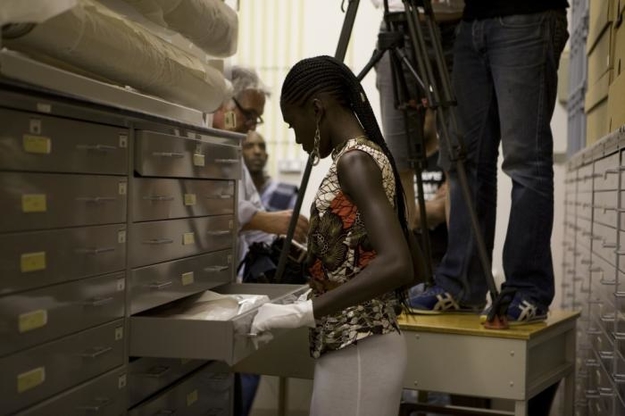Hollandaise
3 November 2012 - 5 January 2013
Godfried Donkor, Abdoulaye Konaté, Wendelien van Oldenborgh, Willem de Rooij, Billie Zangewa.
Curated by Koyo Kouoh.
The exhibition travels on to RAW Material Company, Dakar (Senegal)
The exhibition HOLLANDAISE arises from the deep historical and economic relationship between The Netherlands and the African continent. The title refers to the printed fabric, also known as ‘Dutch Wax’, which has been exported from the Netherlands to West Africa for a century-and-a-half now, and in French-speaking countries like Senegal, Benin and Togo is better known as ‘Hollandaise’. ‘Hollandaise’ is an imitation batik, well-known from the Dutch manufacture company Vlisco. This fabric is widely appreciated in Africa for its high quality, bright and colourfast patterns, and wide variety of designs. With the long presence of ‘Hollandaise’ in West Africa, this characteristic textile has become an essential component of the African identity. It is however a Dutch product, whose origins go back to Indonesian batik, and the mass commercial manufacture of such batik for export to Dutch colonies.
HOLLANDAISE is based on investigative and critical art production responding to this phenomenon. The African curator Koyo Kouoh, based in Dakar, Senegal, proposed inviting five contemporary artists to delve into ‘Dutch Wax’ and the peculiar trade relations and cultural interchanges which this fabric represents. A characteristic of Hollandaise is the history of appropriation of the Indonesian technique. In turn, the five artists have appropriated Hollandaise, and with it its history rooted in colonialism, and applied it for their contributions to the exhibition in Stedelijk Museum Bureau Amsterdam.
The Dutch artist Wendelien van Oldenborgh, whose work often reflects on themes like migration, cultural interchanges and the role of the colonial past in them, made a video film partly based on the story of an African photo model. The contribution by Willem de Rooij refers to the flow of migrants back and forth between Africa, Europe and Indonesia. The South African Billy Zangewa incorporates photos into textile works that often visualize specific places and locations. For Hollandaise she focuses on Vlisco icons, using the subtle material Dupion silk, which comes from the Far East and is much used in Western design clothing. The work of Godfried Donkor, from Ghana, often consists of collages regarding both historical and contemporary media-fed images of Africa. For Hollandaise he made a video film about the importance that his mother and her friends attach to their personal collections of Vlisco fabrics. Abdoulaye Konaté, who lives in Mali, works with used textiles, with which he creates monumental canvases. Examples of his work were to be seen in Documenta 12.
The curator, Koyo Kouoh, is presently the director of RAW Material Company in Dakar. She previously (co-)curated exhibitions such as ‘Hypocrisy: The Site Specificity of Morality’ in National Museum for Art, Architecture, and Design, Oslo (2009) and ‘GEO-graphics, a map of African art practices past & present’ in BOZAR, Brussels (2010). She was also one of the artistic advisors to Documenta 12 and 13.
HOLLANDAISE implicitly raises the colonial history of The Netherlands for discussion. But it also poses questions about the appropriation of culture and the possession of identity. What does one's ‘own’ culture and ‘identity’ mean when such concepts prove to be constantly subject to the laws of the market – in the past too, no less than they are today? And what does it mean when artists in turn appropriate the Hollandaise and literally return it to the country which exported it, The Netherlands? With all of this, HOLLANDAISE seeks to make clear that the relation between The Netherlands and West Africa has long history with lively mutual trading relationships and a high degree of cultural adaptation. But it is also not averse to critical observations from both sides.
This exhibition will be accompanied by a special edition of the SMBA Newsletter, with an introduction by Koyo Kouoh and contributions by the PhD researcher/artist Senam Okudzeto and anthropologist Françoise Vergès.
HOLLANDAISE has been made possible in part by the Mondriaan Fund, the Amsterdam Fund for Art, the SNS REAAL Fund and the Prince Bernhard Cultural Fund.
The exhibition is part of Project ‘1975’ of Stedelijk Museum Bureau Amsterdam.
